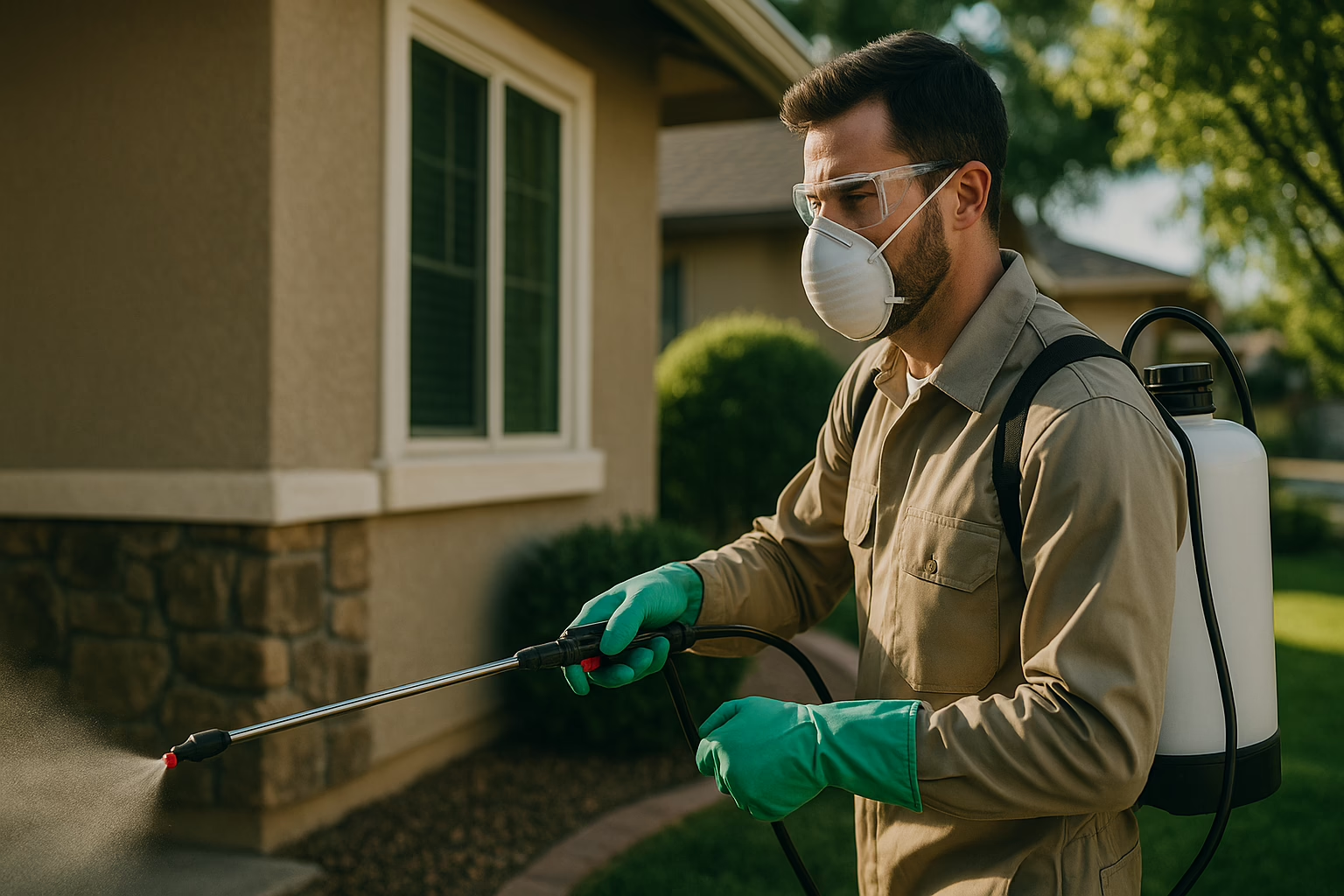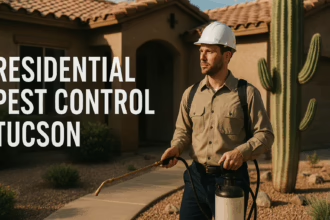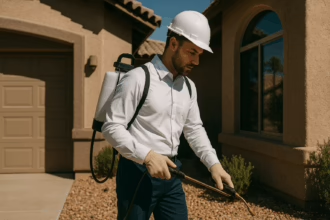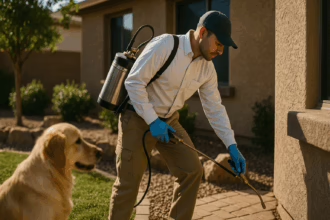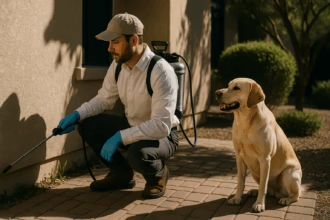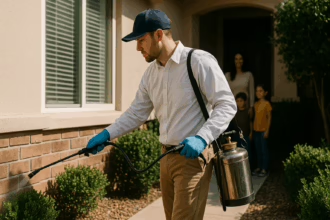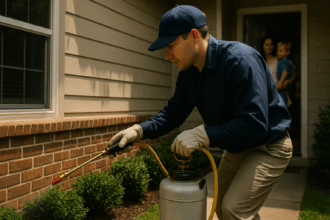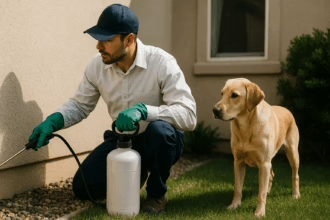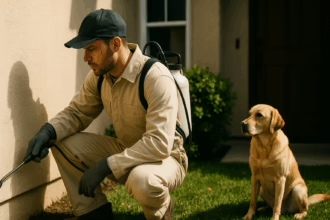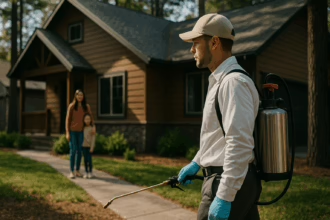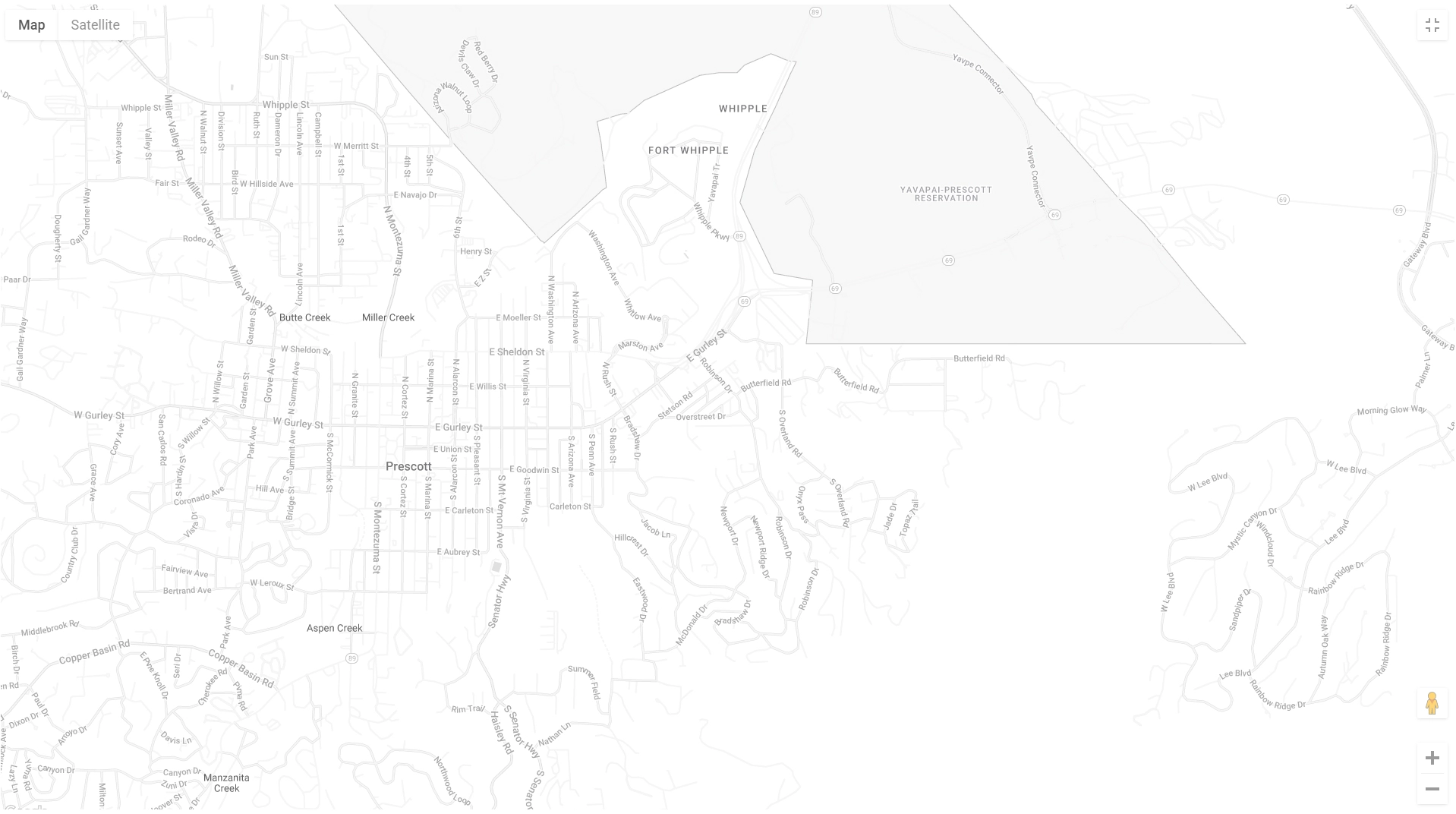Introduction
Prescott’s high-desert climate creates the perfect conditions for ants, spiders, wasps, rodents, cockroaches, and termites to thrive—especially during monsoon season and the cooler months when pests head indoors for shelter. If you’ve tried DIY sprays, you’ve likely noticed they rarely stop recurring infestations—and when misused, they can pose risks to people, pets, and helpful wildlife.
This guide delivers a proven, practical approach to home pest control Prescott homeowners can trust. You’ll learn how Integrated Pest Management (IPM), local expertise, and targeted treatments work together to protect your family and property—safely and effectively.
Understanding Prescott’s Pest Landscape
Common household pests in Prescott and Prescott Valley
Pest pressure varies by neighborhood, but these are the usual suspects in the Quad Cities area:
- Ants: Pavement, harvester, and odorous house ants are common; they trail to kitchens and bathrooms for water and sweets.
- Spiders: House spiders and black widows favor cluttered corners, garages, and eaves where prey collects.
- Wasps and yellowjackets: Paper wasps nest under eaves; yellowjackets can colonize wall voids or ground cavities.
- Rodents: Deer mice and pack rats (woodrats) nest in rock walls, attics, and vehicles, chewing wires and contaminating areas with droppings.
- Cockroaches: German cockroaches thrive in kitchens; larger outdoor roaches can migrate indoors through gaps and drains.
- Earwigs and crickets: Attracted by moisture and landscape lighting, often migrating indoors at night.
- Occasional invaders: Beetles, boxelder bugs, stink bugs, and springtails surge after rains.
- Termites: Subterranean termites are active across Yavapai County; they target wood structures and cellulose debris.
- Bed bugs: Typically travel-related; hitchhike on luggage and used furniture rather than originating outdoors.
Seasonal patterns and climate factors
- Spring: Warmer temperatures trigger ant trails, wasp nest-building, and spider activity.
- Monsoon (summer): Moisture spikes bring earwigs, crickets, roaches, and occasional invaders; termites may swarm after rains.
- Fall: Rodents seek indoor shelter; spiders and wasps may relocate closer to structures.
- Winter: Pests shelter in wall voids, attics, and garages; indoor heating provides ideal conditions for cockroaches and ants.
Elevation, vegetation, and irrigation shape pest pressure. Pine-heavy lots with boulders and wood piles favor pack rats and spiders, while open, irrigated landscapes can draw ants, earwigs, and roaches.
What “Safe Pest Control Prescott” Really Means
Family- and pet-friendly treatment options
Safe pest control Prescott solutions prioritize methods that reduce exposure while improving results:
- Reduced-risk products applied precisely, in the right places and amounts.
- Gel baits and bait stations that target pests where they live and feed, minimizing broadcast spraying.
- Crack-and-crevice applications to wall voids, baseboards, and entry points rather than open areas.
- Exterior perimeter barriers and eave treatments that focus on stop-lines outside your living space.
- Dusts in voids (such as silica or borate-based products) placed in inaccessible spaces for long-term control.
Integrated Pest Management (IPM) fundamentals
IPM blends science, prevention, and targeted control. Core components include:
- Inspection: Identify the pest, its source, and conditions that support it.
- Exclusion: Seal cracks, gaps, and utility penetrations; screen vents; install door sweeps.
- Sanitation: Remove food, water, and shelter; maintain dry, clutter-free areas.
- Habitat modification: Adjust irrigation, trim vegetation, and relocate wood/brush away from structures.
- Monitoring: Use sticky traps and visual checks to verify activity and guide decisions.
- Targeted treatments: Only as needed, with the least-risk method that solves the problem.
The Home Pest Control Process in Prescott
Step 1: Comprehensive inspection and risk assessment
 Online Only Pricing!
Online Only Pricing!
Prescott Pest Control—Fast, Local, Guaranteed
Book in minutes. Lock in our online-only rate and get priority scheduling.
- Stops ants, spiders, mice & pack rats
- No long-term contracts
- Family & pet-friendly options
- Money-back guarantee
Online takes ~60 seconds.
No gimmicks—just your price & schedule.
Prefer to talk? We can't guarantee our online prices over the phone.
We're happy to talk! Call us at (928) 582-8088
A thorough inspection is the foundation of effective home pest control Prescott services. Professionals will:
- Check interior zones: kitchens, bathrooms, laundry, garage, attic, and utility rooms.
- Review exterior features: eaves, fascia, foundations, stucco cracks, expansion joints, and utility lines.
- Identify entry points: door sweeps, window frames, weep holes, conduit penetrations, and crawlspace vents.
- Note conducive conditions: moisture at the slab, wood-to-soil contact, debris piles, and overgrown vegetation.
- Confirm pest identification: trails, droppings, rub marks, webs, nests, and termite mud tubes.
Step 2: Targeted treatment plan
Based on findings, a custom plan focuses on the pests present and the conditions enabling them:
- Ants: Species-specific baits (carb-based or protein-based depending on season), nest targeting, and perimeter exclusion.
- Spiders: Web removal, eave and soffit treatments, and harbor-age reduction in garages and sheds.
- Wasps: Nest treatments during low-activity times; removal of old nests; sealing of favored nesting gaps.
- Rodents: Sanitation and exclusion with hardware cloth and rodent-proofing; trapping strategies matched to the species; secure exterior bait stations when appropriate.
- Cockroaches: Sanitation guidance, gel baits in hinges/voids, crack-and-crevice treatments, and drain maintenance.
- Termites: Monitoring stations, targeted liquid trenching, or baiting systems around structural perimeters.
- Occasional invaders: Adjust irrigation, reduce lighting that attracts insects, and maintain exterior barriers.
Step 3: Prevention and ongoing maintenance
Long-term control depends on prevention designed for local conditions:
- Perimeter barriers refreshed seasonally to intercept pests before they enter.
- Sealing and repairs: Caulking, door sweeps, vent screening, and garage threshold upgrades.
- Landscape adjustments: Trim shrubs off walls, elevate firewood, relocate mulch away from the foundation.
- Irrigation management: Shorter, deeper watering and no drip emitters against the slab.
- Monitoring devices and regular follow-ups aligned with spring, monsoon, and fall cycles.
DIY vs Professional: When to Call a Residential Exterminator in Prescott Valley
Safe DIY steps you can try first
- Seal entry points with caulk, door sweeps, and weatherstripping; screen attic and crawl vents.
- Fix leaks and dry damp areas to deter ants, roaches, termites, and earwigs.
- Reduce clutter indoors and in garages; store items off the floor.
- Store food airtight; clean crumbs, grease, and pet feeding areas promptly.
- Maintain the yard: Trim shrubs, raise wood piles, clear debris, and adjust exterior lighting to yellow “bug” bulbs.
- Use sticky monitors under sinks, behind appliances, and along garage walls to track activity.
- Choose baits over sprays for ants and roaches; avoid over-the-counter broadcast spraying indoors.
Red flags that require a residential exterminator Prescott Valley
Some problems escalate quickly or require specialized tools and products. Call a residential exterminator Prescott Valley homeowners trust if you notice:
- Persistent or large colonies of ants or roaches despite DIY efforts.
- Termite evidence: mud tubes, hollow-sounding wood, or winged swarmers.
- Rodent signs: droppings, gnaw marks, nesting materials, or scratching at night.
- Recurring stings or wasp activity near doors, play areas, or attic spaces.
- Bed bugs or bites after travel or secondhand furniture purchases.
- Pests near kids’ or pets’ areas where extra caution is needed.
Choosing a Provider for Home Pest Control Prescott
Must-have credentials and smart questions
- Arizona licensing and insurance: Verify current credentials and coverage.
- Background-checked technicians trained in IPM and local pest biology.
- Clear treatment plans: What will be treated, where, and why—no vague promises.
- Safety protocols: Pet precautions, re-entry guidance, product labels, and SDS on request.
- Warranties and retreat policies: Know what’s covered and response times for callbacks.
- Product choices: Ask about reduced-risk options, baits, and non-chemical methods.
- Local expertise: Experience with pack rats, monsoon surges, and regional termite pressures.
- Communication: Digital service reports, pictures of findings, and simple follow-up instructions.
Service plans and pricing transparency
- One-time vs ongoing: Single services can knock down a problem; quarterly or bi-monthly plans align with seasonal cycles for prevention.
- Exterior/interior bundles: Routine exterior barriers with interior service as needed reduces indoor exposure.
- Termite add-ons: Monitoring stations, annual inspections, or full perimeter treatments spelled out clearly.
- What’s included: Web removal, wasp nest knockdown, granulation, and follow-up visits should be listed in writing.
- No surprises: Upfront pricing, service frequency, and contract terms explained before you sign.
 Online Only Pricing!
Online Only Pricing!
Prescott Pest Control—Fast, Local, Guaranteed
Book in minutes. Lock in our online-only rate and get priority scheduling.
- Stops ants, spiders, mice & pack rats
- No long-term contracts
- Family & pet-friendly options
- Money-back guarantee
Online takes ~60 seconds.
No gimmicks—just your price & schedule.
Prefer to talk? We can't guarantee our online prices over the phone.
We're happy to talk! Call us at (928) 582-8088
Preparing for Your Service
Before the visit: homeowner checklist
- Clear access to baseboards, under sinks, garage walls, attic entries, and crawlspaces.
- Pets and aquariums: Put away pet bowls and toys; cover fish tanks and turn off aerators if instructed.
- Tidy kitchens: Wipe counters, secure foods, and empty trash to make baits and treatments more effective.
- Trim vegetation touching the home and move firewood away from the foundation.
- Unlock gates and note problem areas (rooms, trails, noises) to share with your technician.
Aftercare: what to expect post-treatment
- Re-entry intervals: Follow instructions on when people and pets can re-enter treated areas.
- Activity “flush”: It’s normal to see increased movement for 24–72 hours as pests encounter treatments.
- Cleaning: Avoid mopping or power washing treated baseboards and exterior perimeters for the time specified.
- Monitors: Leave sticky traps in place; report captures or sightings to guide follow-up.
- Rodent programs: Expect several visits for trapping and exclusion, with adjustments based on findings.
Neighborhood-Specific Tips and Coverage Areas
Prescott vs Prescott Valley vs surrounding communities
- Prescott: Pine canopy, rock outcroppings, and wood features create harborage for spiders and pack rats; manage wood piles and seal garages.
- Prescott Valley: More open terrain with irrigation and new construction can draw ants, earwigs, and roaches; focus on sealing and perimeter barriers.
- Chino Valley: Drier, windier lots; rodents and occasional invaders surge with weather changes; keep vegetation sparse near structures.
- Dewey-Humboldt: Irrigated landscaping and riparian corridors elevate ant, termite, and earwig pressure; adjust watering and monitor for mud tubes.
Exterior features that attract pests in high-desert homes
- Mulch or pine needles against the foundation hold moisture and shelter pests; create a dry buffer zone.
- Stacked firewood near walls invites rodents, spiders, and termites; elevate and store 20+ feet away.
- Drip emitters at the slab keep soil damp, attracting ants and termites; relocate a few feet from the foundation.
- Cluttered sheds and open crawl vents offer nesting sites; declutter and screen openings.
- Unsealed garage doors are a highway for crickets, roaches, and mice; install tight thresholds and side seals.
Frequently Asked Questions
Is it safe for kids and pets?
Yes—when you choose safe pest control Prescott methods. Professionals rely on targeted applications, baits, and reduced-risk products placed where pests live, not where people and pets do. Technicians follow strict label directions, provide re-entry guidance, and use tamper-resistant equipment where needed.
How long do treatments last and how often should I schedule?
Exterior barriers typically last 60–90 days, depending on weather and exposure. For best results in our climate, schedule quarterly service. Homes with heavy pressure (near washes, dense vegetation, or after renovations) may benefit from bi-monthly visits initially.
Will treatments harm pollinators and wildlife?
Responsible programs minimize impact by using selective products, treating during low-activity times, avoiding blooming plants, and focusing on structural perimeters rather than landscape broadcast. Baits and tamper-resistant stations further reduce non-target exposure.
Do I need termite protection in Prescott?
Yes. Subterranean termites are present in the area. Annual inspections and preventative monitoring are recommended, especially for homes with irrigation, wood-to-soil contact, or past activity. Watch for mud tubes, swarmers after rains, and damaged trim or baseboards.
Conclusion
- Local pests follow seasonal patterns driven by spring warmups, monsoon moisture, and fall/winter sheltering.
- IPM and targeted treatments deliver safer, longer-lasting results than broad DIY spraying.
- Choose licensed pros who offer clear plans, reduced-risk options, and warranty-backed follow-ups.
Ready for a safer, smarter approach to protection? Schedule a professional inspection and build a tailored, family-safe home pest control Prescott plan that keeps your home pest-free year-round—backed by local expertise and proven IPM strategies. If you’re nearby, a trusted residential exterminator Prescott Valley can customize service for your neighborhood’s unique conditions.




